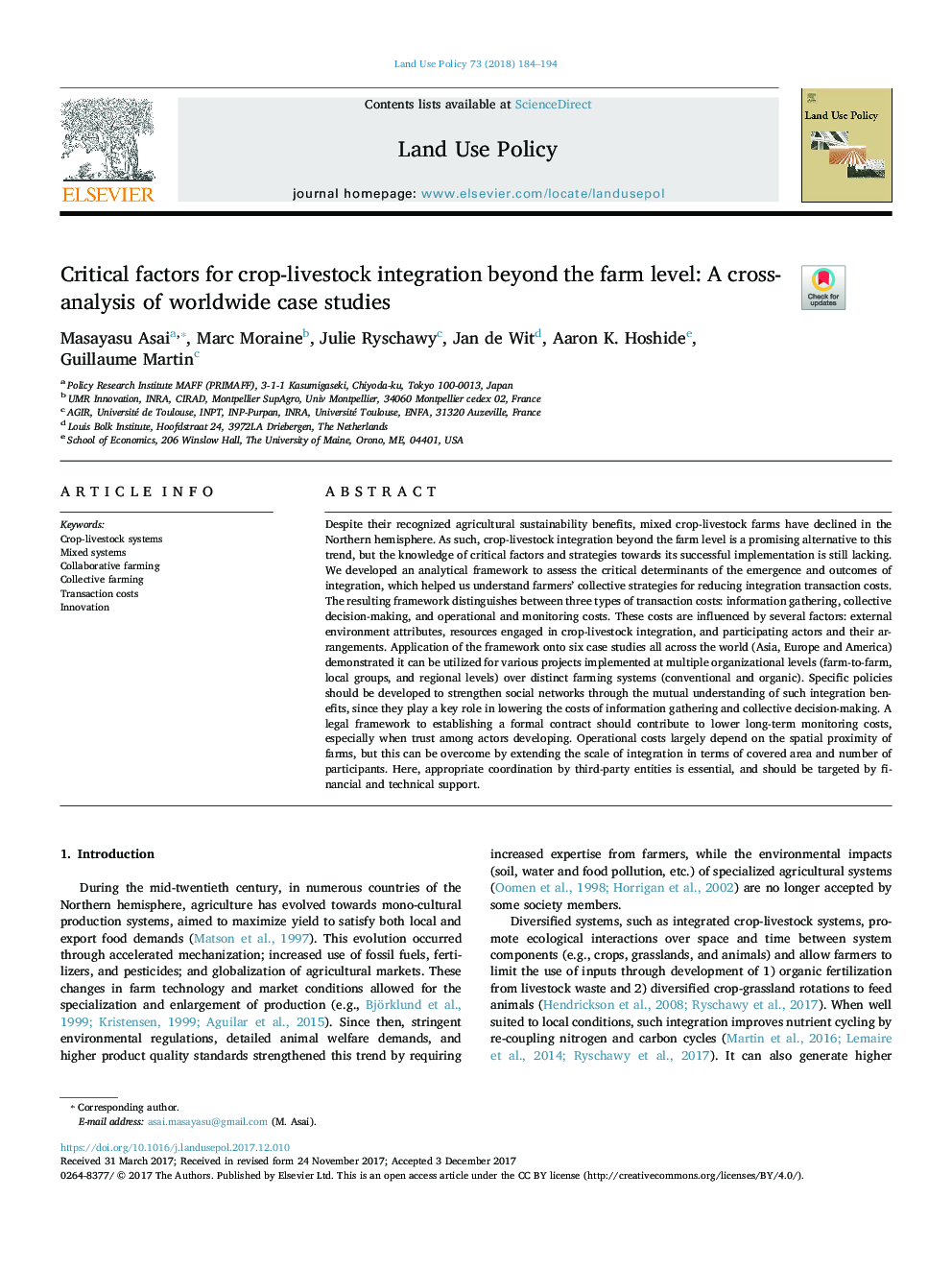| کد مقاله | کد نشریه | سال انتشار | مقاله انگلیسی | نسخه تمام متن |
|---|---|---|---|---|
| 6546509 | 1421810 | 2018 | 11 صفحه PDF | دانلود رایگان |
عنوان انگلیسی مقاله ISI
Critical factors for crop-livestock integration beyond the farm level: A cross-analysis of worldwide case studies
ترجمه فارسی عنوان
عوامل بحرانی برای ادغام محصول و دامداری فراتر از سطح مزرعه: تجزیه و تحلیل متقابل مطالعات موردی جهان
دانلود مقاله + سفارش ترجمه
دانلود مقاله ISI انگلیسی
رایگان برای ایرانیان
کلمات کلیدی
سیستم تولید محصولات کشاورزی، سیستم های مخلوط، کشاورزی مشترک، کشاورزی جمعی، هزینه های تراکنش، نوآوری،
ترجمه چکیده
علی رغم مزایای پایدار کشاورزی خود، مزرعه های مخلوط دامداری در نیمکره شمالی کاهش یافته است. به همین ترتیب، یکپارچگی محصول دامداری فراتر از سطح مزرعه جایگزین امیدوار کننده ای برای این روند است، اما شناخت عوامل و راهبردهای انتقادی نسبت به پیاده سازی موفق آن هنوز فاقد آن است. ما یک چارچوب تحلیلی برای ارزیابی عوامل تعیین کننده ظهور و نتایج ادغام ایجاد کردیم که به ما در درک راهبرد های جمعی کشاورزان برای کاهش هزینه های یکپارچه سازی کمک کرد. چارچوب در نتیجه سه نوع هزینه های معامله را تشریح می کند: جمع آوری اطلاعات، تصمیم گیری جمعی، و هزینه های عملیاتی و نظارت. این هزینه ها تحت تأثیر عوامل متعددی قرار می گیرند: ویژگی های محیط خارجی، منابع درگیر در ادغام محصول و دامداری، بازیگران شرکت کننده و ترتیبات آنها. استفاده از چارچوب در شش مطالعات موردی در سراسر جهان (آسیا، اروپا و امریکا) نشان داد که می توان برای پروژه های مختلفی که در سطوح مختلف سازمان (مزرعه به مزرعه، گروه های محلی و سطوح منطقه ای) بیش از سیستم های کشاورزی متمایز استفاده می شود (معمولی و آلی). سیاست های خاص باید برای تقویت شبکه های اجتماعی از طریق درک متقابل از مزایای یکپارچه سازی توسعه یافته، زیرا آنها نقش کلیدی در کاهش هزینه های جمع آوری اطلاعات و تصمیم گیری جمعی ایفا می کنند. یک چارچوب قانونی برای ایجاد یک قرارداد رسمی باید به کاهش هزینه های نظارتی درازمدت کمک کند، به ویژه هنگامی که اعتماد میان بازیگران توسعه پیدا کند. هزینه های عملیاتی عمدتا به نزدیکی فضایی مزارع بستگی دارد، اما با گسترش دامنه ی ادغام از نظر مساحت پوشیده شده و تعداد شرکت کنندگان، می توان از آن کاست. در اینجا، هماهنگی مناسب توسط نهادهای شخص ثالث ضروری است و باید با حمایت مالی و فنی مورد هدف قرار گیرد.
موضوعات مرتبط
علوم زیستی و بیوفناوری
علوم کشاورزی و بیولوژیک
جنگلداری
چکیده انگلیسی
Despite their recognized agricultural sustainability benefits, mixed crop-livestock farms have declined in the Northern hemisphere. As such, crop-livestock integration beyond the farm level is a promising alternative to this trend, but the knowledge of critical factors and strategies towards its successful implementation is still lacking. We developed an analytical framework to assess the critical determinants of the emergence and outcomes of integration, which helped us understand farmers' collective strategies for reducing integration transaction costs. The resulting framework distinguishes between three types of transaction costs: information gathering, collective decision-making, and operational and monitoring costs. These costs are influenced by several factors: external environment attributes, resources engaged in crop-livestock integration, and participating actors and their arrangements. Application of the framework onto six case studies all across the world (Asia, Europe and America) demonstrated it can be utilized for various projects implemented at multiple organizational levels (farm-to-farm, local groups, and regional levels) over distinct farming systems (conventional and organic). Specific policies should be developed to strengthen social networks through the mutual understanding of such integration benefits, since they play a key role in lowering the costs of information gathering and collective decision-making. A legal framework to establishing a formal contract should contribute to lower long-term monitoring costs, especially when trust among actors developing. Operational costs largely depend on the spatial proximity of farms, but this can be overcome by extending the scale of integration in terms of covered area and number of participants. Here, appropriate coordination by third-party entities is essential, and should be targeted by financial and technical support.
ناشر
Database: Elsevier - ScienceDirect (ساینس دایرکت)
Journal: Land Use Policy - Volume 73, April 2018, Pages 184-194
Journal: Land Use Policy - Volume 73, April 2018, Pages 184-194
نویسندگان
Masayasu Asai, Marc Moraine, Julie Ryschawy, Jan de Wit, Aaron K. Hoshide, Guillaume Martin,
